Here I have posted a small arrangement of extra photos that I would like to share, as they depict my experience in Barcelona as one for the books. I will truly miss the people I have met, teachers I have learned from, and friends I have made while studying here, but I have ultimately learned to take as much as I can from the experience as a whole and apply to the present. I look forward to the adventures to come, and wish the best for those I part ways with at this point along my journey. Cheers to Barce!
Author: djsturgis
El Born
- Make a list of five streets dedicated to craftsmanship or trades and describe them. What were “Els Gremis” (guilds)?
Els Gremis, also known as the guilds, were the areas dedicated to skilled craftsmen, who set up shops within their homes alongside those of the same crafts often times, and locals were able to select from the vendors for products of the greatest quality and price. The streets were named after the crafts, as you can see from the following examples.
Placa de la Llana, Calle de Calders, Carrer de Brocaters, Carrer de Escudellers, Carrer dels Cordors
- “La casa-taller” (The house-workshop) was the typical craftsmanship family house. The same place to live and work. Describe how spaces and stories were organized in a “Casa-taller”.
In La casa-taller, or the home which also served as a workshop, there was a distinct organization that divided the working and living spaces. The shop was in the basement, then there was the principio floor, where the owner lived. The next three floors were additional living spaces for workers, and the servants lived at the highest floor. The windows decreased in size as each floor got higher.
- Observing the buildings of this area of Barcelona, mention some of the main architectural aspects that distinguish the craftsmanwork buildings to the industrial production ones. For exemple, materials, spaces or structures of the buildings and streets.
Some aspects include the windows increasing in size, there being a large window on the primary floors, and the larger windows represented wealthier families. They were built from stone and wood with balconies of iron for the wealthiest families, which were added later on. The door was typically very small and stood to the side of the workshop entrance that resembled a modern-day garage entrance, but smaller. There were tiny stairways, and the outside of the entrance had a sign naming the guild, along with the streetsigns that represented the type of products vended on each particular street.
- Find the cultural relation of this five places cited bellow to catalan culture. Take on account the different historical periods in each case.
- a) Santa María del Mar: Simple column design, showed connection to God and spirituality. The symbol of Catalan people being united is represented by their gathering together in a holy place of religious observation.
- b) El Mercat del Born: The palaces were constructed here by lower-class workers.
- c) El Fossà de les Moreres: This stands as a symbol of the spanish war of succession and Castillia, the heroes depicted as resisting the French attack prior to their death.
- d) La ciutadella Park (The Fortress of Philip V by 1714): the fortress was built by Philip V in order to keep Catalans from rebelling, and served as a protective barrier from attack.
- After September 11th 1714 the decrees of Nova Planta were proclaimed in Catalonia by Philip V. Mention the main changes in catalan society doing a little research after the Field study.
The decree of Nova Planta established a spanish nationalit that has not existed prior to this. Legally, there was no defined difference between Arogan and Castillia. The internal borders and customs also ceased to exist, which allowed Spanish people to finally begin trade with American colonies.
- What is el Consolat de Mar?
El Consolat de Mar is the place where boats arrived along the coast in order to announce the type of goods they planned to bring to the city and learn what taxes were necessary to bring them. They were later able to seek establishment of their craft in a trade area, such as El Born.
Focus

We truly are in a state of digital shock. After spending around twenty minutes deleting photos because my storage was endlessly full as per usual, I took this photo while exploring the most beautiful and magnificent city of Montecarlo. This was taken while walking down along the shoreline of the Gardens in the Oceanographic Museum near the Princier Palais atop the highest peak of the mountains in Monaco. The view was spectacular. You could see mountains beyond the gorgeous castles and towers all planted atop smaller hills that concaved with rows of multicolored condos and casinos all cascading downwards into a small bright blue rocky-bottomed port containing lines pearly while, spectacular yachts lined up like beached whales enjoying the warm sun above.
The photo is a perfect depiction of today’s digital epidemic. I wish that society could banish the use of our tiny devices of mass destruction when in places such as this. The girl in the photo was unaware of my presence, because her focus was consumed entirely by what was taking place on the two by four screen in front of her. It truly is a pity that today’s youth, including the generation I grew up in, sometimes (accurately) referred to as the Millenials, are so obsessed with the digital availabilities that we can no longer persist to focus on what is taking place in the true present, in reality. We are so eager to stay in touch virtually on each of our various networks, personal blogs, and digital messaging that we are repeatedly failing to contribute to society in the purest of social forms: verbal communication. Texting has replaced calling which has replacing talking in person which has become an atrocious display of get togethers during which there will almost certainly begin a cycle of “checking” ones phone for notifications- or rather, egotistical reassurance that someone is virtually recognizing one’s presence. That is a harsh description, and an exaggeration at large, but I find it necessary to call attention to the negative repercussions that the digital age is calling for. It is so rare these days that I come across someone who still uses their home phone, or even has one to begin with. We have lost the ability to feel secure in our immediate non-virtual presence, as we are constantly searching for some sort of recognition through unprecedented, lifeless communication such as the likes we receive on a given post, the specific people viewing our snap chat stories, or the amount of time someone takes to reply to a text. These have become the standard measurements for today’s notion of “popularity” which is increasing our individual sense of self-criticism and therefore leading to a society less willing to exist in the present and engage in a genuine, uncensored, creative conversation. That being said, I urge you to phone a friend, leave your devices at home, and just go talk. You’ll never know how liberating it might feel unless you try.
For further thorough interpretation on this topic, I suggest checking out the book by Douglas Rushkoff. Preview can be found at the following link:
http://www.wired.com/2013/03/digiphrenia-excerpt-from-douglas-rushkoffs-present-shock/
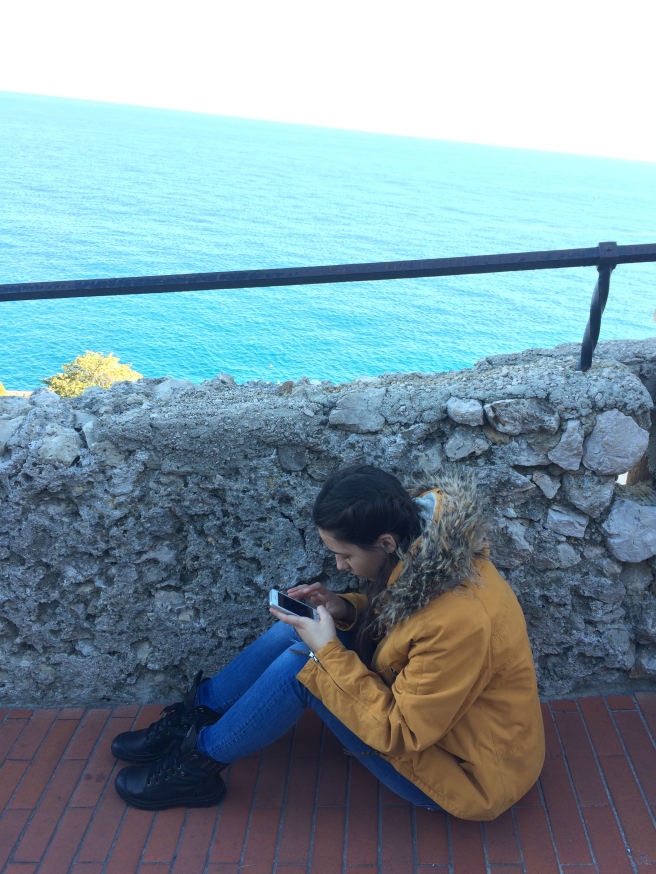
We truly are in a state of digital shock. After spending around twenty minutes deleting photos because my storage was endlessly full as per usual, I took this photo while exploring the most beautiful and magnificent city of Montecarlo. This was taken while walking down along the shoreline of the Gardens in the Oceanographic Museum near the Princier Palais atop the highest peak of the mountains in Monaco. The view was spectacular. You could see mountains beyond the gorgeous castles and towers all planted atop smaller hills that concaved with rows of multicolored condos and casinos all cascading downwards into a small bright blue rocky-bottomed port containing lines pearly while, spectacular yachts lined up like beached whales enjoying the warm sun above.
The photo is a perfect depiction of today’s digital epidemic. I wish that society could banish the use of our tiny devices of mass destruction when in places such…
View original post 363 more words
La Ribera ~ El Born ~ Raval
The well renowned area known as El Born, is truly a somewhat hidden gem in the midst of the city. Considering I live approximately a ten minute walk to the corner of the neighborhood where it connects to the Parc de Ciutadella (where I have been many times), it came as quite a shock to learn that behind the large historic Born Market, there are a million restaurants and cafes that I would have been dipping into between classes all semester had I known their proximity to both my school and home. However, they aren’t going anywhere, and for this I am sure as this neighborhood has obtained its historic charm despite being rebuilt in many areas after the Spanish civil war. The architectural reconstruction resembles that previous to the war, copying the style and foundational works that were maintained through design maps and plans that were luckily preserved.
Gallery Hopping
The AICAP Gallery Hopping Field Trip consisted of a moderately short stroll between three separate galleries, each one focused on vastly different styles of art, but with an identical audience. That audience was no where to be found, despite my expectations that the casual, temperate Friday afternoon would provide the perfect locale for at least a decent portion of locals and tourists alike to engage in a leisurely activity like gallery hopping. However, the first dimly lit, vaguely blank gallery was empty aside from the somewhat mundane artwork hanging on its walls, and it quickly became evident that regardless of the free admission, the natives heavily lacked interest.
As the group parted ways, we were encouraged to stop into a gallery, as they are free of charge and some truly contain hidden gems. I chose to take advantage of my free time, and investigate by making a few additional stops. However, stopping into the lesser-known exhibitions only proved the point true: Galleries all over Barcelona are struggling, and it is due to the misconception that they are costly to attend, and boring to observe. There is no entrance fee for smaller galleries, which you can find on almost every other block in some areas. Three of these highly intricate and better known galleries that we visited were Galería Joan Prats, Galería 3 Punts, and N2 Galeria. The exhibitions in all three contained somewhat abstract elements, but varied in styles, from sculptures to bland paintings, to real life objects turned aesthetic.
I would not have discovered the opportunity to grow in my knowledge of these varying types of art, nor would I have been exposed to the existence of galleries alone had I not joining in on this AICAP activity. It is highly encouraged that others take advantage of these trips, as you never know what you might learn or see. If you allow it to, a gallery can draw you in and mesmerize your artistic side that you were unaware existed.
The interesting thing that galleries have to offer is the ability to analyze deeper into the work of art, whether it be a painting, sculpture, or other piece of abstract, contemporary or modern art. Rather than simply flipping through a book or magazine, you can truly spend time to observe the surrounding art and immerse yourself into the culture this way.
Catalonian Independence: Tourist & Local Perspective: Local News 2
“The Catalonian Independence Movement Just Hasn’t Gained my Attention”
Students and local residents report minimal opinions regarding a large issue debated
Barcelona, Spain
One of the first things a newcomer might notice upon arriving in Barcelona is the overwhelming presence of the Catalan Flag. Hung from just about every other balcony, the symbol of division between those who advocate for and against an independent state is evident, yet it remains almost inconspicuously powerful. However, American students studying abroad in Barcelona have been living in the capital of Catalonia during the peak of this fight for Catalonian independence, yet still seem to know nothing about it.
“I’m not really sure what the deal is with the Catalan independence movement but it seems like a huge deal around here. I think it has something to do with money… maybe not. I’m not sure actually,” Macy Walton said.
The study abroad experience is advertised as an intense cultural immersion in a new country. Students expect to acquire knowledge about the current events and issues in their new home but that often isn’t the case. The Catalan Independence Movement is the most important issue currently happening in Barcelona and arguably, in Spain. “Before coming here, all I knew about the Catalan independence movement is that some people in Barcelona speak Catalan and some people speak Spanish. I leave next week and I’m embarrassed to say that, for the most part, that’s still all I know,” said student Nicole Shaul.
The Catalonian desire to gain independence from the rest of Spain is rooted in the protection of its culture after the Franco dictatorship aimed to demolish any existence of Catalan culture. The preservation of language is viewed by many residents as the central effort put forth in order to keep the culture intact, contributing to a strong sense of identity which continues to slash through the region. Economically, supporters of Catalonian independence argue that the residential taxes paid to the central government of Spain do not equal the benefits received. The rising rates of unemployment in the region support their argument, in addition to the substantial amount of debt it has accumulated in the wake of the global financial crisis. Additionally, Madrid’s focus on strengthening the country’s poorest areas fails to include Barcelona, which many view as unfair.
The divide also exists between those who have a strong opinion and those who hold little regard for the outcome of the debate. Lupe Roca, a host mother who has been living in Barcelona for the past twenty-five years, has a much lighter opinion on the subject. Born in Mallorca, she admits to a lack of concern for the issue but has many friends who are passionate about the subject as they report believing that it could affect the future of their children. When asked about her opinion, Lupe had a simple reply, “Es una tonteria…” (translated from Spanish) “I think that it is impossible for Catalonia to become independent. I agree that it would function better with less dependence on Spain, but I also believe that Spain should be one. I just want what is best for all of Catalonia.” It was somewhat unclear where she stands on the issue, but typical to most locals, she had no desire to begin a debate on the topic because of its long and tiring presence here in Barcelona.
Some study abroad students live with Catalan host families who are very passionate about the fight going on. It is evident that some of those students are provided with an inside look at what it is like to be part of a Catalan family. “I have tried to learn about both sides of the debate, but I really don’t feel that I am educated enough on the issue to form my own opinion,” Emily Lancaster said. “All I know is that my host family has made me feel at home here, so I support them and their desire for independence.”
Conversely, some students decided not to branch out while abroad and instead, spent their time with other Americans. Because most study abroad programs give students the freedom to spend their time as they wish, the level of cultural immersion one experiences is up to them. “The language barrier was the main reason I spent most of my time with Americans. Looking back on it, I wish I would’ve got out of my comfort zone more but it’s really intimidating to be in a foreign country alone and being with other Americans made that a lot easier,” Macy Walton said.
Ultimately, it may be fair to conclude that many people you encounter in class on a daily basis are studying abroad but are they genuinely learning as well? Those living with host families are certainly the rare breed, but have seemingly gained a more dynamic perspective from which to view the issue.
La Boqueria: Food
La Boqueria is a marketplace that I have become quite familiar with, as it is located along Las Ramblas, close to my study center, CEA, and serves as a cheaper alternative to grabbing a snack in a cafe in between classes. It is also a sensual experience; seeing the beautiful work being done with meats and raw fish, tasting samples of different bars of chocolate bark and nougats, eating some of the freshest fruit in smoothie form if you like, smelling the various cheeses and spices that line the stalls within the marketplace. The people are mainly locals seemingly in a rush, but on the weekends you will encounter a flurry of tourists, jam packed into the space in order to preview an authentic Barcelona market experience. The gelato here compares to none other, and gelato being my favorite food, I will dedicate the following entire post to the subject. Stay tuned…
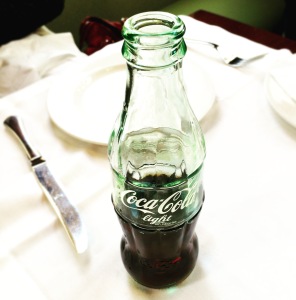



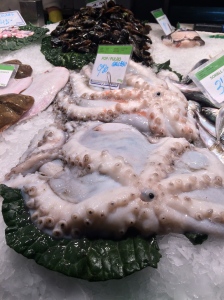
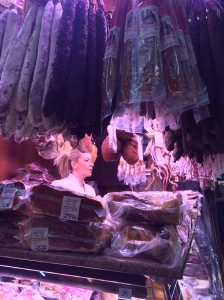

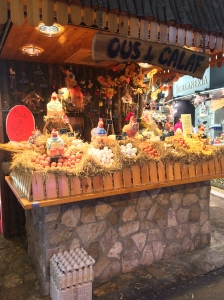
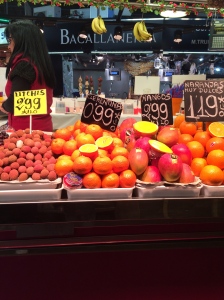

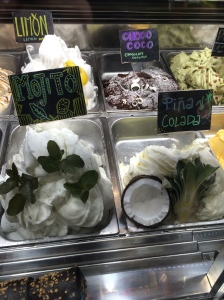

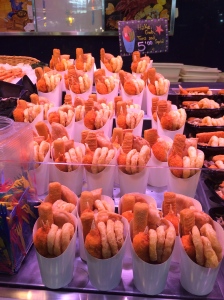
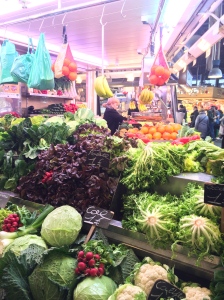
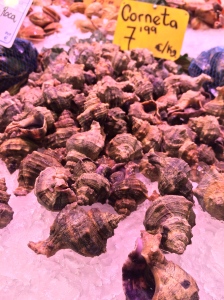

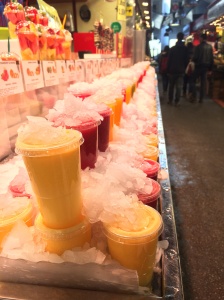
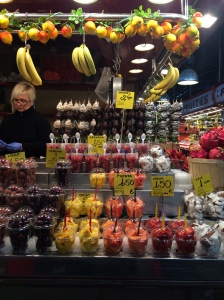

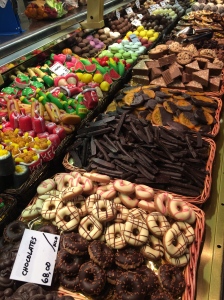
Barchitecture


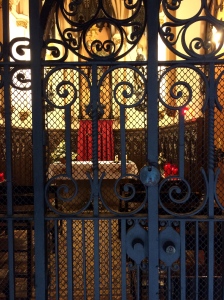


Throughout the various field trips we embarked upon in the past four months, I gained a much greater sense of the Roman and Gothic architectural foundations that form the inner city of Barcelona. The intricate detail of monuments from the 1800s take your breath away when you first lay eyes upon them, and authentic old feeling you gain when entering an outdoor cafe in the Born district that lies in the middle of what would have been a royal courtyard in the Roman days, sitting within the walls that are original from those times. It all adds up to create a cultural, historic experience like none I have experienced elsewhere.
What struck me as the most beautiful in both the tranquil feeling within its threshold and the architecture inside and out, were the churches and cathedrals located throughout the city. From Santa Maria del Mar, to smaller churches spoken entirely in Catalan in Poble Nou, to La Sagrada Familia, to the Monastery atop Montserrat Mountain, I have gone to a mass at each one, and have been silenced to astonishment upon entering all of the above. Coming from a very religious family, I have always attended mass on Sunday, but while traveling abroad this has not always been possible, as the time is limited and unfortunately traveling makes it less of an easy activity to attend. However, I was able to go to quite a few more than I had thought, and enjoyed my experience as the masses are often shorter, more casual in dress and mannerisms, and the services are wonderful even if I did not understand a word of Catalan, or struggled to apprehend the Spanish spoken so rapidly within the congregation. These are the experiences that I will never forget, and look forward to telling and sharing with my family in the years to come.
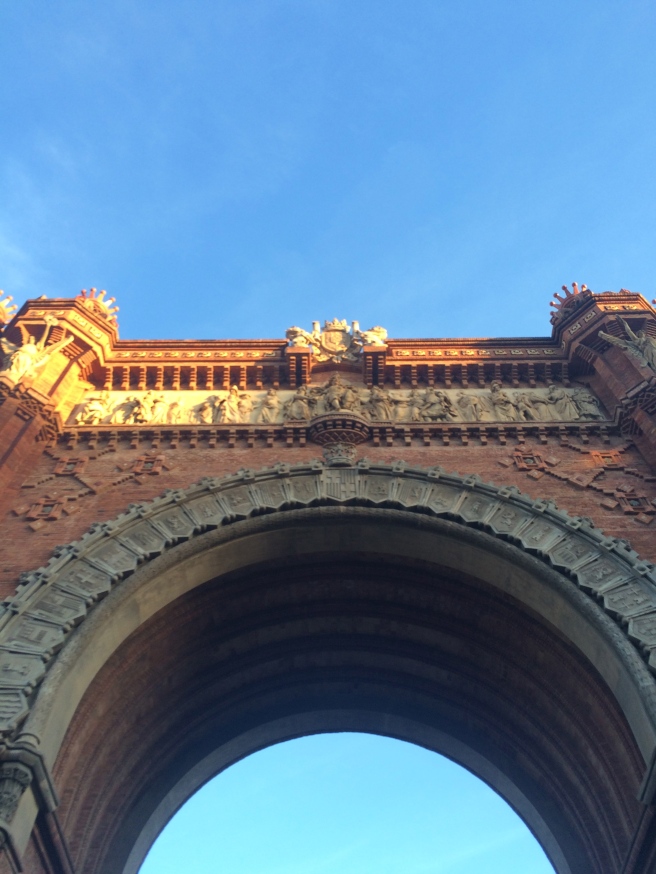
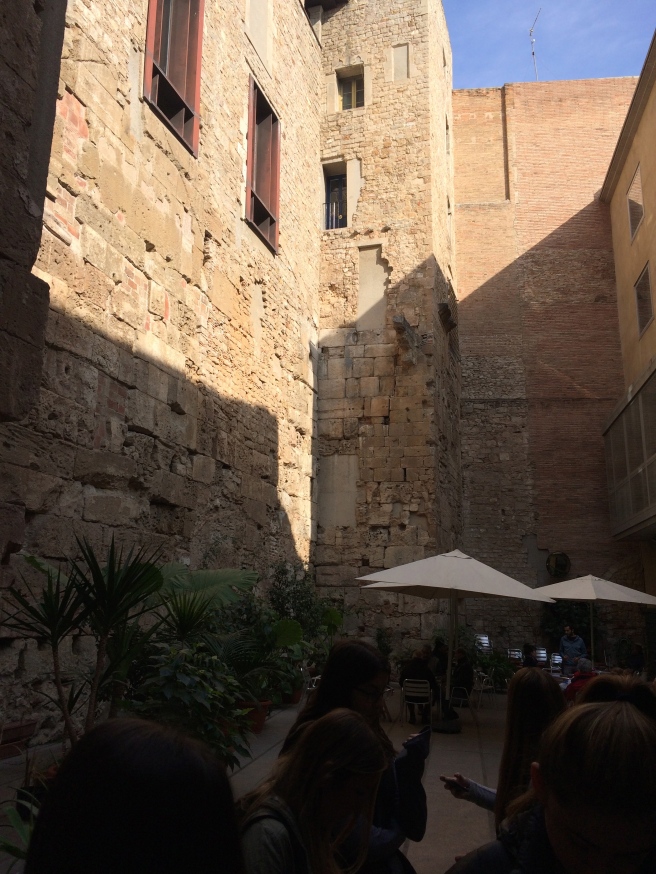
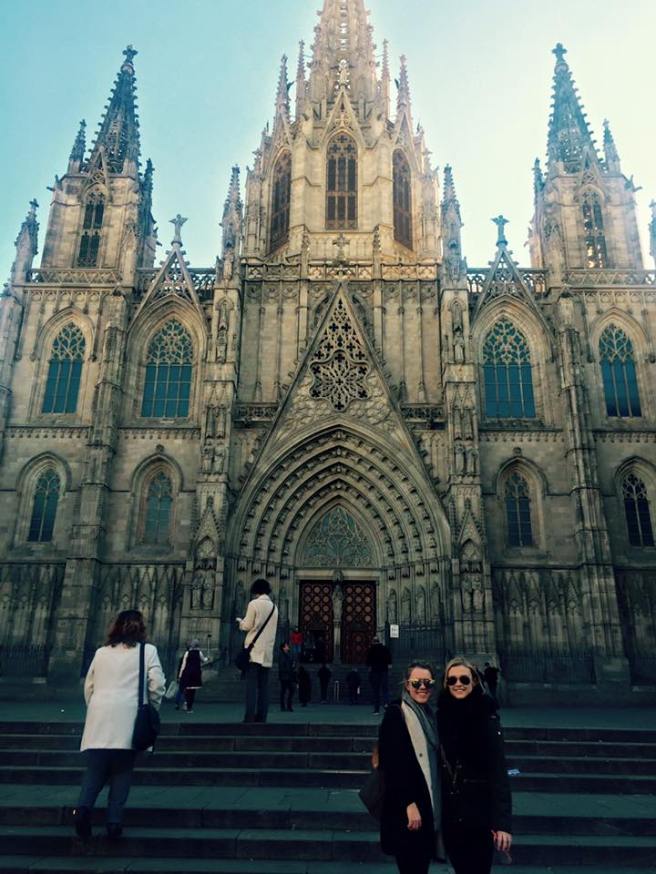
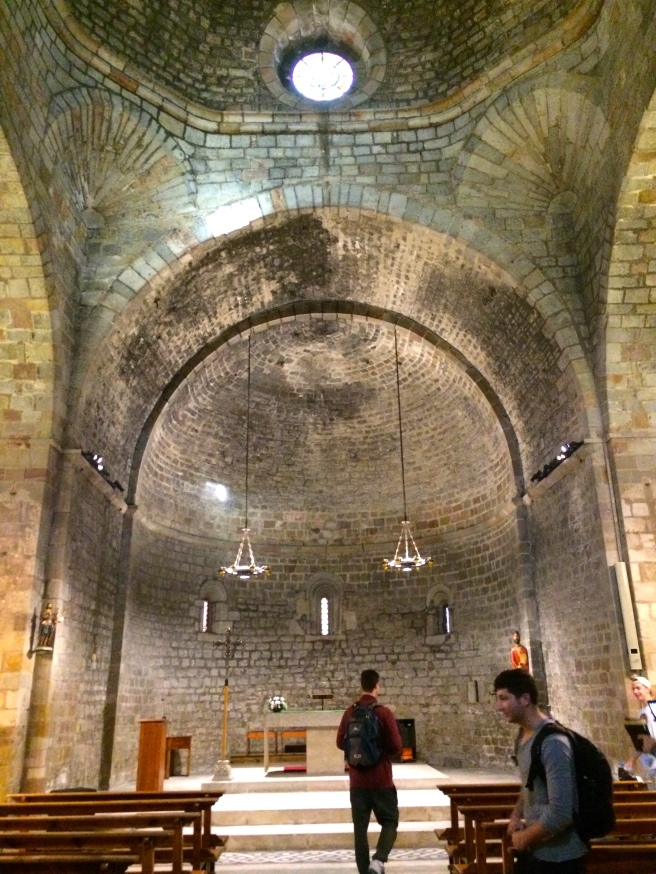
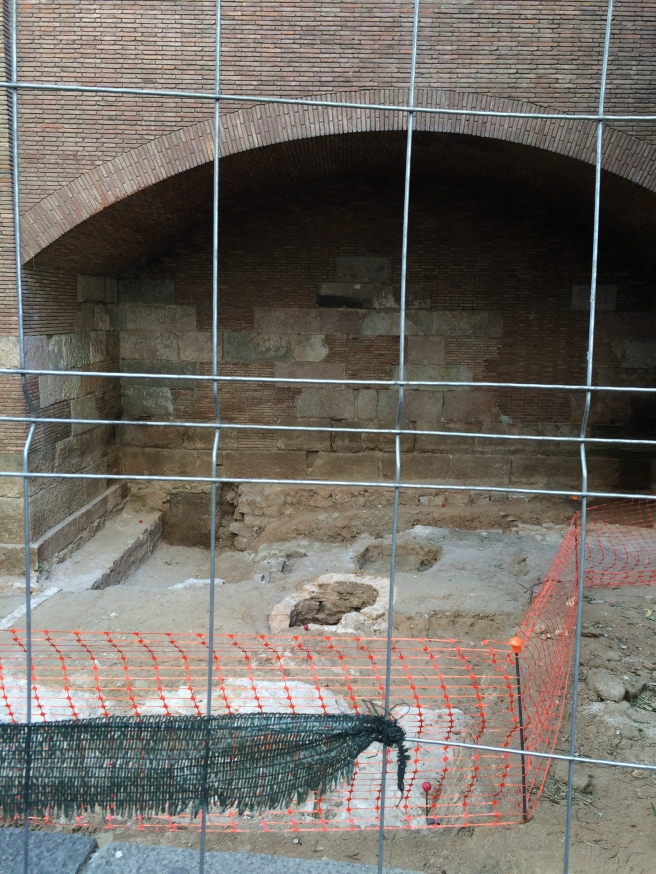
Field Trip, Barri Gotic
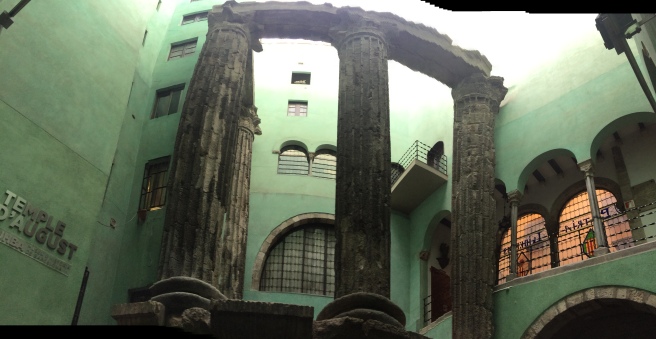
More Questions Answered
- In comparison to today’s modern Catalan buildings, there are vast differences mainly in the foundational structures of many prominent monuments, however, as we travel further towards the outer city, the similarities continue to diminish in the particular details portrayed withinn the architecture, yet the Roman influence still remains prevalent.
3.
We also find similarities like these in american architecture, however on a much more modern scale. The plots and layouts of neighborhoods resemble those first inhabited by the colonies in the americas during the late 1400s, as the suburban structure somewhat copies the idea of a colony. The first 13 colonies in america provided structure to social classes and divided racial groups, and these two distinctions continue to live on in modern layouts of suburban (and some rural) populations. They can best be viewed from above, as the neighborhoods tend to contain winding roads, with houses planted in identically fashioned rows, most of the exterior of the house structures also appearing identical.
4.
The shells and pottery used as utensils, and the smaller objects made of Stone and Wood in order to put on makeup, were vastly smaller tan typical objects of the sort today. It expressed the minimalism that existed during this century, and the simplicity of life in comparison to the expansive choice of objects we obtain today.
Dyes and urine used for laundry services was most surprising to me because although the technique of performing the laundry duties was carried out immensely similarly, the use of urine seems both unsanitary and anti-climatic. The cycle of laundry was however profoundly similar to the system we currently use which was very interesting to learn.
5.
Wine being used as the blood of Jesus Christ, continues to serve its purpose in Roman Catholic and many Christian churches throughout the world. The Romans’ use of large wine canisters was wise, as we continue to search for the larger materials in order to keep wine contained and pure, although this practice has understandably been abandoned. Not in its entirety however, as we continue to use large barrels, another cylindrical shape, to hold and ship wine. Two examples of popular types of wine served in Catalunya today are Cava and Priorato. In addition, one sparkling wine Brand would be Mestre Mas Via.


























































































